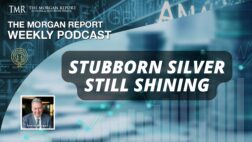We find this month’s report challenging because there are now so many writers in the silver space, and this was not the case a decade ago. So much information has been spread on the Internet since the rise and fall of the silver market that we are compelled to give you our insights to separate some of the fact from fiction. Also, before moving on, we have obtained and read both of the new silver reports that are published annually.
One is from the CPM Group in New York, titled, The CPM Silver Yearbook 2011, and the other is from the Silver Institute, titled, The Silver Institute World Silver Survey 2011.
Your publisher has subscribed to both of these publications every year from the time of their initiation. Although the data can be disputed (we ourselves have raised questions), it is a starting point and we can quote, cite, and oftentimes verify the data ourselves. What we find fascinating is how many writers in the silver space take information from some Web site and run with it. In other words, “somebody” said (fill in the blank) and they make their whole discussion about what someone else published without even knowing how the data was obtained, let alone verifying any of the information.
We do not want to give the impression that we “know it all”; in fact, quite the opposite. You might take the attitude of questioning everything we write or state either for our paid members or in public. Being able to think critically is vitally important and a very rare commodity these days. However, we do our best to cite our work; when we use “facts,” we so state, and when we are providing opinion, we also do our best to let everyone know that as well.
The CPM Silver Yearbook $150
See: http://store.cpmgroup.com
The Silver Institute World Silver Survey $225
See: http://www.silverinstitute.org/publications.php
As you can see, to subscribe to both publications costs $375 per year. Consider that we comment on the most important points each year for our members, and a full year of our basic service is only $130 per year.
Both of these books on the silver market overlap on several important points. First, the fact that INVESTMENT DEMAND is crucial to the higher silver price. Both also call attention to China’s importance as a major global silver consumer. As we have mentioned many times, much of solar panel production comes out of China, and this area is growing rapidly and will continue, regardless of recession or not.
The CPM Group said it developed better estimates of silver use in China and developed what it feels are sufficiently reliable statistics on Chinese silver mine production, scrap recovery, and fabrication demand. We will not dispute this. We also know from our strong relationship with the Silver Institute that a delegation from the Silver Institute meets with the Chinese every year for the same purpose.
Again both studies indicate that China’s silver demand has grown perhaps 300%–400% over the last decade. Remember in the year 2000 the Silver Institute estimated that Chinese consumption of silver was 1/70 that of North America. So, if we use the current forecast number, the Chinese are using something like 1/20 the amount now. Obviously huge growth, but in our view the growth could continue for quite some time as China continues to grow in the technological arena.
Of course we have maintained from the beginning that it is investment demand that is the key to higher silver prices (industrial demand is important), so let’s pause and look at the latest information about Chinese silver investment demand.
The following is from Shi Heqing, a silver analyst at Beijing Antaike Information Development Company.
Silver trading in Shanghai jumped 65 percent in terms of volume last month (April), and will continue to increase on demand for a safe-haven investment, even as the government moves to curb volatility and speculation.
“Chinese investors have piled into silver as one of the investment choices to hedge against rising inflation. The government’s move to increase margins in an effort to curb volatility won’t affect buying interest in physical material,” Shi said.
Volume on the Shanghai Gold Exchange rose to 33,293 metric tons in April, up from 20,206 tons the previous month, according to data from the exchange, the main bourse in China for trading silver. The central bank raised reserve requirements a day after reports showed inflation and lending exceeded economists’ estimates in April, with consumer prices rising more than 5 percent. China turned to a net importer of silver in 2010, a situation that has not changed this year, according to Antaike.
CPM predicts Chinese silver fabrication demand will rise 15.6%, to 177.2 million ounces this year. Chinese consumer demand for jewelry and silverware has been strong, CPM noted. “Silver jewelry demand remained steady because it is comparatively more affordable than gold or platinum jewelry. In addition, many Chinese consumers are said to prefer the white color of silver jewelry to the yellow color of gold.”
As we all know, silver was up 78 percent in 2010 and silver posted an average price of $20.19 in 2010, a level only surpassed in 1980, and a marked increase over the $14.67 average price in 2009. Ed. note: nominal price—not inflation adjusted!
According to the Silver Institute, world investment demand rose by an impressive 40 percent last year, to 279.3 million troy ounces, resulting in a net flow into silver of $5.6 billion, almost doubling 2009’s figure. This of course is significant on relative terms looking at silver only, but so ridiculously small, relative to global financial markets. This is why we know silver has not made its final top.
The Silver Institute makes the point that exchange traded funds (ETFs) registered a huge performance in 2010, with global ETF holdings reaching an impressive 582.6 million ounces , representing an increase of 114.9 million ounces over the total in 2009.
In March, the Telegraph reported that holdings in the iShares silver trust (SLV), one of the largest silver ETFs in the world, increased by 179 tonnes on the back of increased interest in the metal. By the start of May, the situation had reversed and vehicles such as the iShares fund claimed record redemptions. CNBC reported that the ETF saw $1 billion redeemed by the 5th of May, which in turn helped to feed silver’s price fall.
What we find so interesting is that the SLV had no trouble bringing in new physical silver at the same time that the Sprott Physical Silver Trust (PSLV) had a very difficult time. As we have all heard many times, a picture is worth a thousand words, and we thank one of our loyal members for sending the following . . .
Reserved for our paid members– you may be able to find it on the web!
The data in this chart is directly from the SEC, which states, “We cannot guarantee that the data will be posted by a particular date. We cannot guarantee the accuracy of the data.”
Remember a failure to deliver is recorded when a seller does not provide the shares of stock that were sold within the required three-day settlement timeframe. From the SEC: “Fails-to-deliver can occur for a number of reasons on both long and short sales. Therefore, fails-to-deliver are not necessarily the result of short selling, and are not evidence of abusive short selling or ‘naked’ short selling.”
“The values of total fails-to-deliver shares represent the aggregate net balance of shares that failed to be delivered as of a particular settlement date if the balance is 10,000 shares or more. Fails to deliver on a given day are a cumulative number of all fails outstanding until that day, plus new fails that occur that day, less fails that settle that day. The figure is not a daily amount of fails, but a combined figure that includes both new fails on the reporting day as well as existing fails.”
We know there is huge controversy surrounding the SLV and we have examined this in depth in our Master Mind series. We remain in the middle that much of the silver purported to be in the SLV is there; our main concern is whether or not it is totally unencumbered.
Recently the SLV claims to have 325 million ounces of silver, while the Comex has about 32 million in the registered category, which for all practical purposes is the only silver available to the dealers. In other words, the SLV is 10 TIMES BIGGER, purportedly, in physical metal. Which one do you think would have the greatest impact on the market—especially considering that we are becoming more and more of a physical market?
David Morgan
Sign up for the Morgan Report Today!
http://www.silver-investor.com/amember/signup.php



